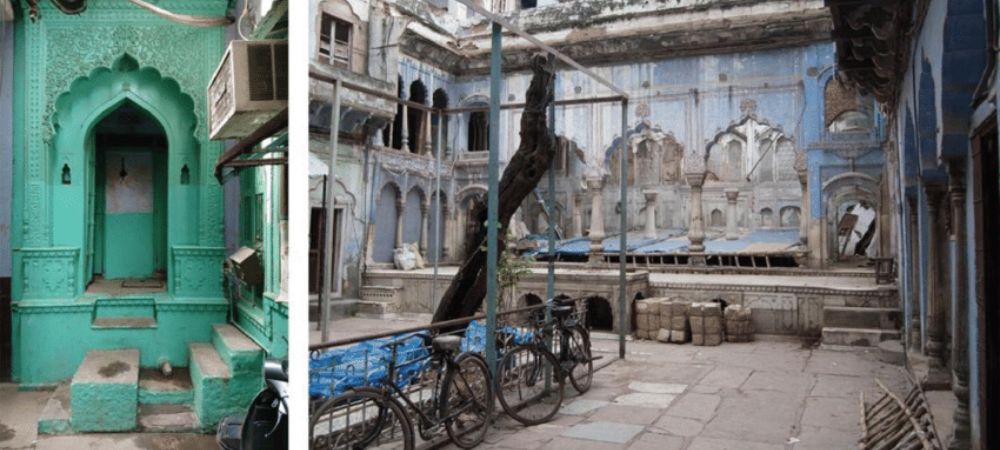|
Getting your Trinity Audio player ready...
|
Delhi, a city of stories, whispers its past through the crumbling facades of forgotten havelis in Shahjahanabad, the walled city built by Emperor Shah Jahan in the 17th century. While the Red Fort and Jama Masjid continue to attract tourists, tucked away in the labyrinthine alleys of Old Delhi are remnants of a bygone era—grand havelis that once housed nobility, poets, and traders but now stand neglected, waiting for someone to listen to their silent echoes.
Echoes of the Mughal Era
During the Mughal period, Shahjahanabad was a thriving center of commerce, art, and literature. Wealthy merchants, courtiers, and aristocrats built stunning havelis—multi-courtyard mansions adorned with intricate jaali work, Persian-style arches, and grand wooden doorways. These havelis were not just homes; they were symbols of status, culture, and power.
One such haveli was Begum Samru’s Haveli, a European-styled mansion built by the influential noblewoman Begum Samru, who played a significant role in Mughal politics. Another, Mirza Ghalib’s Haveli, once housed the legendary poet, where he penned verses of longing and despair. Today, while a section of Ghalib’s haveli has been restored into a museum, many other havelis remain in ruins.
Don’t Miss: Exploring Tughlaqabad Fort: A Forgotten Gem of Delhi
From Palaces to Ruins
As Delhi modernized, these havelis fell victim to neglect, urbanization, and real estate pressures. Many families, unable to maintain them, sold off portions or converted them into commercial spaces. Several havelis now serve as godowns, crammed with sacks of spices, fabrics, and machinery. The few that are still inhabited tell tales of fading royalty, with old chandeliers covered in dust and walls echoing laughter that once was.
The Struggle to Preserve Heritage
Organizations and history enthusiasts have tried to bring attention to the decaying havelis, urging the government and heritage bodies to intervene. Some efforts, like the restoration of Dharampura Haveli—now a luxurious boutique hotel—show that revival is possible. However, the battle to save these architectural gems is far from over.
A Walk Through Forgotten Glory
If you wish to experience the forgotten havelis of Shahjahanabad, take a slow walk through Chandni Chowk, Ballimaran, or Chawri Bazaar. Look beyond the modern chaos and you’ll spot grand doorways, ornate brackets, and lattice windows peeking through. The best way to explore them is by engaging with locals, some of whom have lived in these havelis for generations and carry stories passed down through time.
Final Thoughts
The havelis of Shahjahanabad are more than just buildings; they are silent witnesses to Delhi’s layered history. While some have been lost forever, a few still stand resilient, fighting against time and indifference. Perhaps, with the right attention and love, these forgotten mansions might once again shine as they once did, reminding us that history isn’t just in books—it’s alive, breathing, waiting to be cherished.
Featured Image Credit: researchgate.net
Don’t Miss: The Mystery Behind Bhuli Bhatiyari Ka Mahal
Common Questions About Shahjahanabad
Q. What is Shahjahanabad called now?
Ans: Shahjahanabad is now known as Old Delhi, the historic walled city established by Mughal Emperor Shah Jahan in 1639. It remains a cultural and commercial hub, home to landmarks like Chandni Chowk, Jama Masjid, and the Red Fort, blending rich heritage with the bustling chaos of modern-day Delhi.
Q. What were the havelis meant for?
Ans: Havelis were grand mansions built for Mughal-era nobility, merchants, and aristocrats. They served as luxurious residences, social gathering spaces, and symbols of wealth. Designed with multiple courtyards, intricate carvings, and sprawling layouts, they provided privacy, ventilation, and a refined lifestyle rooted in Persian and Indian architectural traditions.
Q. What are the 14 gates of Shahjahanabad?
Ans: Shahjahanabad originally had 14 gates, some of which still stand today. The most famous include Lahori Gate, Delhi Gate, Ajmeri Gate, Kashmiri Gate, Turkman Gate, Mori Gate, and Daryaganj Gate. These gates were key entry points into the walled city, providing security and controlled access to traders, travelers, and residents.
Q. What are the features of a haveli?
Ans: A traditional haveli boasts large courtyards, intricate jaali (lattice) work, carved wooden doors, arched gateways, and spacious rooms. These mansions emphasized natural ventilation, privacy, and aesthetic elegance. Built with red sandstone or brick, many had underground cellars, rooftop terraces, and stunning Mughal and Rajasthani architectural influences.
Don’t Miss: Majnu Ka Tila: A Tibetan Food Paradise in Delhi

